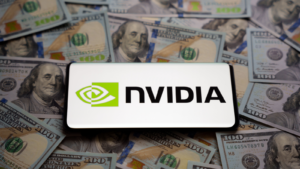One notable strategic advantage of the first is its revenue diversification across several technological platforms and end industries. This helps mitigate risks related to industry swings. High-performance computing (HPC) and smartphones account for a sizable amount of the company’s revenue.
On the other hand, the second company is charting a course for solid development in the client and data center segments despite challenges in other areas. Its unwavering focus on strategic goals and transparent sales projections ensures a promising trajectory. The third company’s success in the automotive industry underscores its growth potential, with revenue reaching significant milestones driven by partnerships and the increasing adoption of autonomous driving technology.
Find out how these semiconductor stocks are growing their market share and innovating; they offer exciting prospects.
TSMC (TSM)

One strategic strength of TSMC (NYSE:TSM) is its revenue diversity across several technological platforms and end industries, mitigating risks related to industry changes. In Q4 2023, TSMC contributed revenue from several platforms, including digital consumer electronics (DCE), smartphones, the Internet of Things (IoT), automotive, and HPC.
Moreover, the biggest shares, each accounting for over 40% of sales, are from the HPC and smartphone divisions. During 2023, TSMC’s top-line was mostly 81% from HPC and smartphones combined. Through 2023, TSMC’s income from the smartphone and HPC categories remained high despite variations in particular industries. These divisions grew over the previous quarter, with HPC rising by 17% year-over-year (YOY) and smartphones rising by 27% YOY in Q4.
Further, by diversifying its top-line, TSMC may take advantage of growth prospects in several sectors. Meanwhile, this lessens the effects of obstacles unique to a certain industry. Between $28 billion and $32 billion is TSMC’s estimated capital budget for 2024, with a sizable amount going into new process technologies. To sum up, the organization supports future growth aspirations while ensuring optimal resource use through its conservative approach to CapEx.
AMD (AMD)

For Q1 2024, AMD (NASDAQ:AMD) projects a top-line of around $5.4 billion, with growth potential in the data center and client businesses. Although the embedded and gaming sectors may fall, long-term estimates call for robust double-digit percentage growth in the data center and client segment revenues. Furthermore, AMD’s optimistic view is fueled by growth prospects in critical domains. This includes client solutions and data center computing, even in the face of headwinds in some industries.
Moreover, with an operating margin of 23%, AMD’s operating income for the fourth quarter of 2023 was $1.4 billion. In Q4, operating income for the Data Center segment was $666 million, or 29% of sales; for the Client segment, it was $55 million, or 4% of revenue; for the Gaming segment, it was $224 million, or 16% of revenue; and for the Embedded segment, it was $461 million, or 44% of revenue.
Finally, the data center and embedded sectors have significantly greater operating margins. To conclude, AMD’s total operating income remains strong despite the client segment’s lower margins, demonstrating its capacity to profit from a variety of product lines.
NVIDIA (NVDA)

Q4 Fiscal 2024 saw a 21% YOY rise in NVIDIA’s (NASDAQ:NVDA) automotive revenue, which was $281 million. This revenue was up 8% sequentially and crossed the $1 billion barrier for 2024. Automakers use the company’s DRIVE platform to build intelligent car computers and autonomous driving systems, including products like DRIVE Orin and DRIVE Thor.
Additionally, partnerships with leading companies such as Li Auto (NASDAQ:LI), ZEEKR, and Great Wall Motors (OTCPK:GWLLF) signify that NVIDIA’s automotive solutions are becoming highly relevant in numerous automotive markets. Similarly, the revenue rise in 2024 reflects NVIDIA’s fundamental capability to gain a greater portion of the automotive industry. Indeed, this is propelled by the growing demand for intelligent vehicle computing systems and autonomous driving tech.
Moreover, NVIDIA’s top-line growth is still robust in other markets, even if regulatory hurdles have caused a fall in data center revenue from China. Interestingly, global investments in AI infrastructure are helping NVIDIA’s sales grow outside of China and the United States.
To summarize, growth and revenue diversification are fueled by NVIDIA’s Hopper architecture and InfiniBand networking, which have become industry standards for accelerated computing.
As of this writing; Yiannis Zourmpanos held long positions in TSM, AMD, and NVDA. The opinions expressed in this article are those of the writer, subject to the InvestorPlace.com Publishing Guidelines.
Yiannis Zourmpanos is the founder of Yiazou Capital Research, a stock-market research platform designed to elevate the due diligence process through in-depth business analysis.
